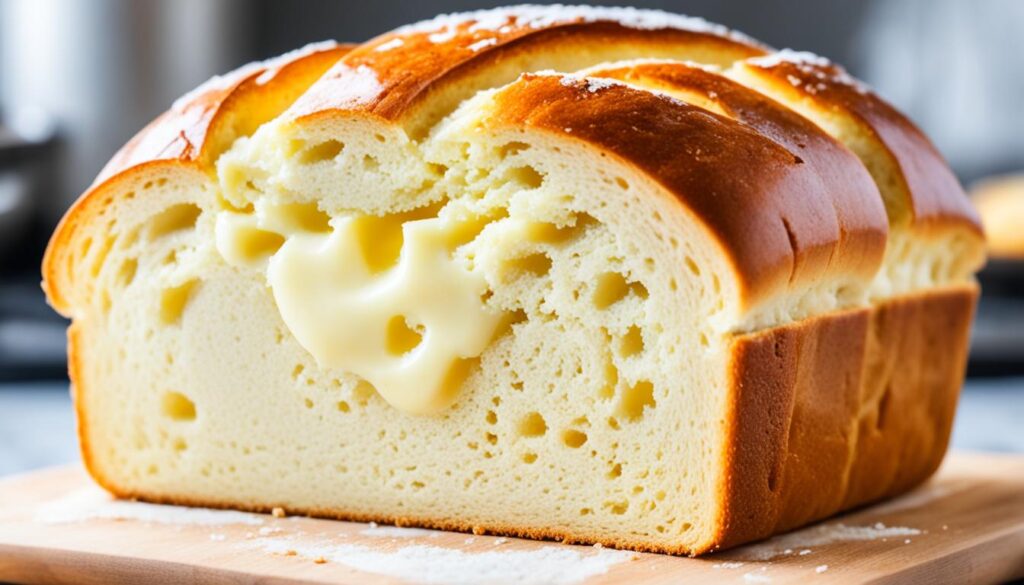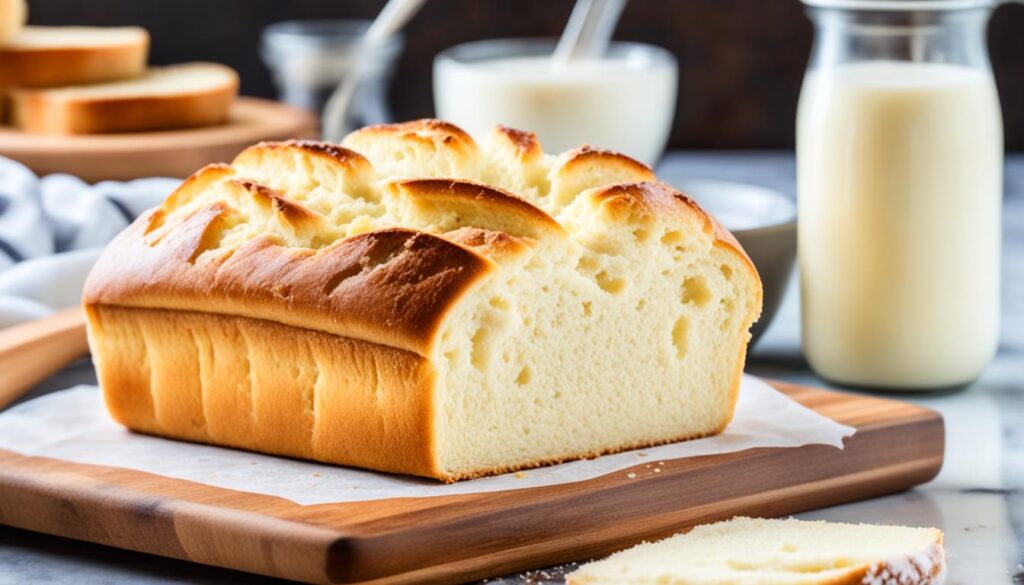There’s something truly magical about the process of baking bread at home. The aroma that fills the kitchen, the anticipation as the dough rises, and the satisfaction of biting into a warm, fluffy slice of freshly baked goodness. And when it comes to the ultimate bread-making adventure, there’s one recipe that stands out above the rest: Japanese milk bread.
Japanese milk bread, also known as shokupan, is a heavenly creation that combines the delicate texture of a cloud with a subtle sweetness that melts in your mouth. It’s the kind of bread that makes you close your eyes, take a deep breath, and savor every single bite. And the best part? You can easily make it in your own kitchen.

Imagine waking up to the irresistible aroma of freshly baked Japanese milk bread wafting through your home. Picture yourself spreading a thick layer of butter on a slice of this pillowy perfection, or using it to create the most mouthwatering sandwiches. With this easy-to-follow recipe, you’ll be able to recreate the magic of Japanese bakeries right in your very own oven.
So dust off your apron, gather your ingredients, and get ready to embark on a journey that will transport your taste buds to a world of fluffy deliciousness. In this article, we’ll guide you step-by-step through the process of creating the perfect Japanese milk bread. From understanding the unique techniques to mastering the art of shaping and baking, we’ve got you covered.
No more longing for a trip to Asia or settling for store-bought bread that never quite hits the mark. It’s time to embrace the joy of baking at home and experience the sheer delight of sinking your teeth into a slice of the softest, most heavenly bread imaginable. Get ready to indulge in the wonder of Japanese milk bread and elevate your baking skills to a whole new level.
Table of Contents
Introduction to Japanese Milk Bread
Japanese milk bread, also known as shokupan, is a beloved bread with a soft and fluffy texture and a subtly sweet taste. This popular bread is a staple in Japan, enjoyed as breakfast toast and in sandwiches. In this section, we will delve into the tangzhong method, explore the unique flavor profile of milk bread, and uncover the historical roots of shokupan.
Understanding the Tangzhong Method
The tangzhong method is a fundamental technique used in the preparation of Japanese milk bread. It involves cooking a mixture of flour, water, and milk into a paste called tangzhong. This paste is then added to the dough, contributing to its exceptional softness and springy texture. The tangzhong method is responsible for creating the signature fluffy and light consistency that makes Japanese milk bread so delightful.
The Unique Flavor Profile of Milk Bread
Milk bread showcases a distinct flavor profile that sets it apart from other bread varieties. The addition of milk and butter lends a gentle sweetness and richness to the bread, enhancing its overall taste. As you bite into a slice of milk bread, you’ll experience the perfect balance of flavors that make it irresistible.
The Historical Roots of Shokupan
Shokupan, or Japanese milk bread, has a rich history deeply intertwined with Japanese food culture. It has been enjoyed as a staple food in Japan since the early Meiji era, undergoing modifications over the years to cater to the preferences of the Japanese palate. Shokupan’s enduring popularity and continuous evolution reflect its importance in Japanese cuisine and the enduring love for this delectable bread.
Essential Ingredients for Authentic Japanese Milk Bread
To make authentic Japanese milk bread, you will need the following essential ingredients:
| Ingredients | Role in Japanese Milk Bread |
|---|---|
| Flour | Bread flour is preferred for its higher protein content, which helps with gluten development and gives the bread its structure. |
| Milk | Full-fat milk or whole milk is commonly used in Japanese milk bread to add richness and moisture to the dough. |
| Sugar | A small amount of sugar is added to provide sweetness and to feed the yeast, helping the bread rise. |
| Butter | Unsalted butter adds flavor and richness to the bread. It is important to use softened butter for easy incorporation into the dough. |
| Salt | Salt enhances the flavors and balances the sweetness in the bread. |
| Yeast | Active dry yeast or instant yeast is used to leaven the bread and create the desired light and fluffy texture. |
The Art of Shaping Your Milk Bread Loaf
Shaping the dough is an important step in creating the perfect Japanese milk bread. It not only affects the appearance of the bread but also plays a crucial role in determining its texture and overall quality. Whether you’re making dinner rolls or a loaf bread, mastering the art of shaping will take your milk bread to the next level.
If you prefer smaller, individual servings of milk bread, dinner rolls are the perfect option. To achieve consistent and evenly sized rolls, the dough should be portioned into smaller pieces, usually around 75g each. This ensures that each roll has a uniform shape and bakes evenly. Home bakers often use a scale to accurately measure the dough and maintain consistent portion sizes.
Dinner Rolls vs. Loaf Bread
While dinner rolls are a popular choice for individual servings, milk bread is equally delicious in the form of a loaf. The process of shaping a loaf bread requires a slightly different technique but is just as rewarding.
Whether you choose to make dinner rolls or a loaf bread, shaping your milk bread is an essential step that requires attention to detail and a bit of practice. By mastering the art of shaping, you’ll create bread that not only looks impressive but tastes absolutely delightful.
Variations of Japanese Milk Bread
There are various ways to create unique variations of Japanese milk bread, resulting in different textures and flavors. Let’s explore two popular variations: rounded top shokupan and flat top shokupan, as well as the option of incorporating dough enhancers for an even softer and fluffier bread.
Rounded Top Shokupan
Rounded top shokupan refers to the loaf bread that is baked without a lid, allowing it to rise and form a beautifully rounded top during baking. This technique results in a lighter and softer texture, perfect for those seeking a pillowy and delicate slice of milk bread.
Flat Top Shokupan
On the other hand, flat top shokupan is baked with a lid placed over the loaf pan. This prevents excessive evaporation of moisture and creates a more moist and chewy texture in the bread. The flat top style is preferred by some for its denser and richer mouthfeel.
Incorporating Dough Enhancers
To take your Japanese milk bread to the next level of softness and fluffiness, you can consider incorporating dough enhancers into your recipe. Dough enhancers, such as dough conditioners or dough improvers, are specially formulated products that improve the quality of bread and contribute to a longer shelf life.
These enhancers work by providing additional strength and elasticity to the dough, resulting in a more tender and airy texture. They can be particularly helpful if you live in a location with dry or low-humidity climates, as they help retain moisture in the bread, keeping it soft and fresh for longer.

When using dough enhancers, make sure to follow the manufacturer’s instructions and incorporate them into your recipe accordingly. Experimenting with these additives can lead to even more satisfying results and an elevated milk bread experience.
Now that you know the different variations and options for enhancing the texture of your Japanese milk bread, you can get creative in your own kitchen and explore the multitude of delicious possibilities that this beloved bread has to offer!
Tips and Tricks for Perfect Japanese Milk Bread
If you want to achieve the perfect Japanese milk bread, here are some tips and tricks that will help you achieve a fluffy and delicious loaf.
Use weighted measurements: Instead of relying on volume measurements, it’s best to use a kitchen scale to measure your ingredients. This will ensure accuracy and consistency in your bread-making process.
Activate the yeast properly: To ensure that your yeast is active and ready to leaven the bread, make sure to use lukewarm water and let it sit until it becomes foamy. This step is essential for the dough to rise properly and achieve that light and airy texture.
Be patient when incorporating butter: Incorporating softened butter into the dough can take some time, but it’s important to be patient. Take your time and slowly mix in the butter until the dough becomes smooth and elastic. This will ensure that the butter is evenly distributed and creates a rich and flavorful bread.
Allow proper proofing time: Proper proofing is crucial for achieving the desired texture and flavors in your Japanese milk bread. Make sure to give the dough enough time to double in size during the proofing process. This will help create that soft and fluffy texture that makes Japanese milk bread so irresistible.
Brush with egg wash: Before baking, brush the top of your Japanese milk bread with an egg wash. This will give your bread a beautiful, shiny crust that adds to its visual appeal.
Store in an airtight container: To keep your Japanese milk bread soft and fresh for longer, store it in an airtight container. This will help maintain its moisture and ensure that you can enjoy its pillowy goodness for days to come.
Baking at Home: The Joy of Creating Fluffy Japanese Milk Bread
Baking Japanese milk bread at home is an experience that brings immense joy and satisfaction. The entire process, from mixing and kneading the dough to watching it rise and filling your home with the irresistible aroma of freshly baked bread, is truly delightful.
With the step-by-step recipe and helpful tips provided in this article, you have all the guidance you need to achieve the same level of pillowy perfection as the ones you find in Japanese bakeries. No need to travel far or wait in line, you can now create your very own fluffy and delicious Japanese milk bread right in the comfort of your own kitchen.
So, put on your apron, gather your ingredients, and embark on this culinary adventure. The joy of baking your own bread from scratch is just a few simple steps away. Get ready to savor the satisfaction of indulging in a soft, cloud-like slice of homemade bread that will leave you craving for more.
Perfect Japanese Milk Bread Recipe
Description
Indulge in soft, airy bread with a subtle sweetness.Perfect for sandwiches or toasts.
Ingredients
apanese Milk Bread Ingredients
Instructions
apanese Milk Bread Instructions
-
Combine yeast, warm milk, and sugar. Let sit.
-
Mix flour and salt in a bowl.
-
Add yeast mixture, water, egg, and butter.
-
Knead until dough is smooth and elastic.
-
Let dough rise for 1-2 hours.
-
Punch down and shape dough.
-
Place in greased loaf pan and let rise.
-
Preheat oven to 350°F. Brush loaf with milk.
-
Bake for 25-30 minutes. Cool before slicing.
Nutrition Facts
Servings 12
- Amount Per Serving
- Calories 0.2kcal
- % Daily Value *
- Total Fat 3.67g6%
- Saturated Fat 2.33g12%
- Cholesterol 25.83mg9%
- Total Carbohydrate 35g12%
- Sugars 3.33g
- Protein 0.5g1%
* Percent Daily Values are based on a 2,000 calorie diet. Your daily value may be higher or lower depending on your calorie needs.




